Thinking About Cognition in Instructional Design
by Alyssa Lawson, Ph.D.
When deciding how to design material for a course, you might think “how can I design material that is going to effectively transfer the information I want my students to know into my students’ brains?” This is a question that all instructors have thought at least once and likely think every time they put together new content or edit previously used content. If you have thought this, you are not alone! There are many decisions to make when designing instructional material. In this article, I am going to talk about the way in which you can design content that aligns with the way in which your students’ brains think, in order to help you design effective content.
I am going to start this discussion by diving into two theories of cognition, so bear with me. These tips come from two psychological theories that explain how brains process learning content: cognitive load theory (CLT; Sweller, 1988; Sweller et al., 1998) and cognitive theory of multimedia learning (CTML; Mayer, 2021). Although there are several differences to these theories, those are beyond the scope of this article. For the most part, and the part that is relevant to instructional design, these theories are telling us the same thing. That is, students have a limited cognitive capacity for new information, but not all cognitive capacity that is used up during a lesson is the same. There are actually three types of processing that can occur while learning that have different implications for learning.
The first type of processing that can occur is called extraneous load (according to CLT) or extraneous processing (according to CTML). This type of processing occurs when learners are processing information that is not relevant to the goal of the lesson. For example, when students are paying attention to their phone in class, this would be considered extraneous processing. Extraneous processing also occurs when information that is interesting but irrelevant to the goal of the lesson, known as a seductive detail, is presented that does not support the students’ understanding the material at hand. This type of processing is not beneficial to learners as it takes up cognitive capacity that does not support their understanding of the material. As such, to support students’ learning, the ultimate goal is to reduce extraneous processing as much as possible.
The second type of processing that can occur is called intrinsic load (according to CLT) or essential processing (according to CTML). This type of processing occurs when learners are trying to build a mental representation of the material that is being presented to them. This type of processing is essential to learning and must occur for learning to happen. However, with content that is especially complex, interrelated, or new to learners, essential processing increases. This is because these lessons require students to use more cognitive capacity to create these mental representations. This type of processing must occur for students to learn, but other types of processing are associated with deeper understanding, so it is beneficial for learning to not be taken up fully by essential processing. As such, to support students’ learning, the ultimate goal is to manage essential processing.
The last type of processing that can occur is called germane load (according to CLT) or generative processing (according to CTML). This type of processing occurs when learners are developing a deeper understanding of the content through creating connections within the content itself and between the content and the students’ prior knowledge. This type of processing is highly desirable in learning because it is associated with a better understanding of the material. However, this type of processing is not necessary for learning to occur, but it does help with longer retention of the material and better understanding. Therefore, not all students use this type of processing when it comes to learning. As such, to support students’ learning, the ultimate goal is to encourage generative processing.
Now, I’ve just spent a long time talking about theory, which doesn’t really help answer the question that opens this article. So, as promised, I will now give you some concrete suggestions on ways to incorporate what cognitive load theory/ cognitive theory of multimedia learning tell us about learning into instructional design.
Ways to reduce extraneous processing:
- Remove information that is not relevant to the goal of the lesson (coherence principle). This can look like:
- Removing seductive details, or details from your instruction that do not relate to the lesson itself.
- Removing images from slides that do not help your students understand the material better.
- Removing fancy fonts or crazy animations from a slideshow presentation.
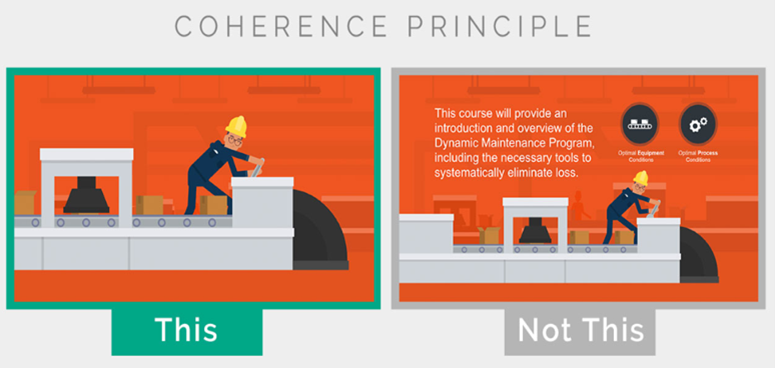
- Add signals that direct your students’ attention toward important information (signaling principle). This can look like:
- Highlighting the most important ideas on your slides.
- Using arrows throughout a presentation to direct students’ attention to the important content.
- Circling key words that students should focus on.
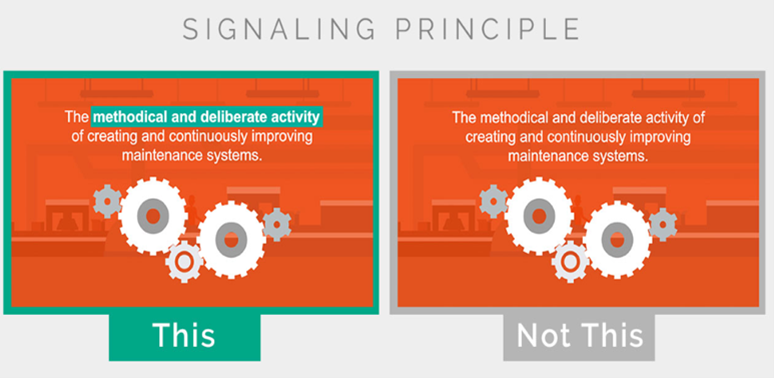
- Keep information that is related together (spatial and temporal contiguity principles). This can look like:
- Moving text from below a picture into the picture in relevant spots.
- Discussing information only when the relevant information is presented on screen.
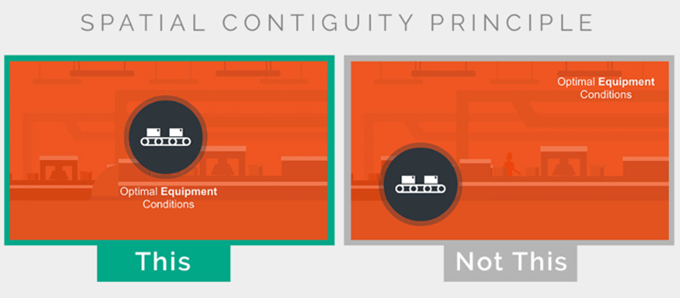
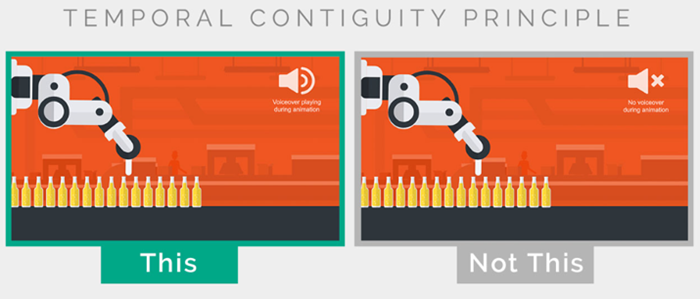
Ways to manage essential processing:
- Break a complex lesson into parts that the students can learn step by step (segmenting principle). This can look like:
- Presenting a complex model in parts so each node is presented one at a time.
- The entire lesson is broken down into sections.
- The learner has control over the pace of the lesson, so they can stop at parts where they need to spend more time processing.

- Teach pieces of the content prior to the lesson, to help familiarize students with the material (pre-training principle). This can look like:
- Having students learn important vocabulary from the lesson prior to learning the full lesson.
- Introducing students to new instructional technology prior to using it for learning.

Ways to encourage generative processing:
- Encourage students to engage deeper with learning, through generative learning activities. These strategies include things like:
- Having students summarize what they learned (summarizing).
- Having students explain to themselves different parts of the material (self-explanation).
- Having students draw a visual representation of the material (drawing).
- Having students test themselves on their knowledge (self-testing).
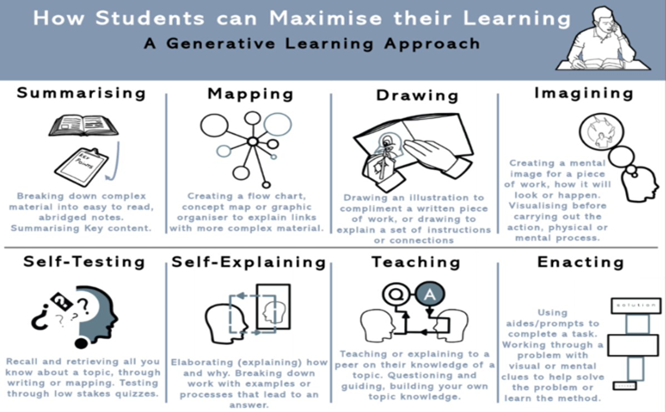
- Use personal language when talking to your class (personalization principle). This will help students develop a personal connection to the material and help get them more invested in understanding. This can look like:
- Using first- and second-person language instead of third-person language.
- Having students think about information in relation to themselves.
- Presenting information using causal language instead of sounding too professional.
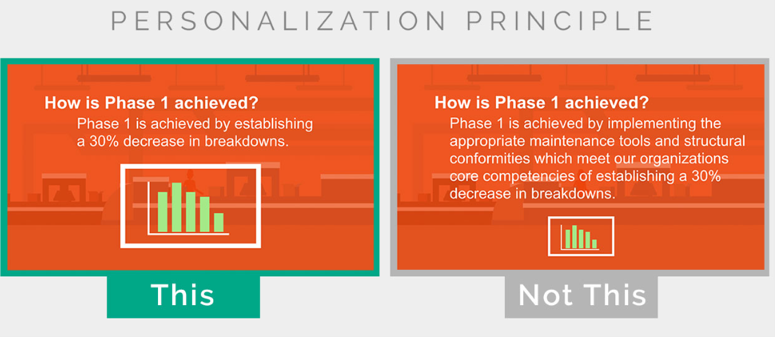
The last tip I have for you when it comes to designing your teaching content is to keep in mind that your brain is also operating the same way as your students; you have a limited capacity for new information as well. As such, when making new instructional material or modifying material you already have, make sure to introduce new teaching principles slowly so you too can get used to it. Happy designing!
Images from DeBell, 2019: https://waterbearlearning.com/mayers-principles-multimedia-learning/ and Main, 2021: https://www.structural-learning.com/post/generative-learning-a-teachers-guide